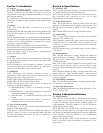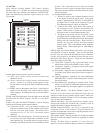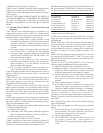
7-1.2 Other tools which may be required are:
7-1.2.l AC/DC Voltmeter for taking voltage readings and an
Ohmmeter for testing resistance of wires and connections.
7-1.2.2 Jumper wires with alligator clips to bypass or simulate
circuit closures.
DO NOT USE THESE JUMPER WIRES TO CHECK IF
VOLTAGE IS PRESENT AT A TERMINAL BY DRAWING
AN ARC TO GROUND. THIS WILL DAMAGE OR
DESTROY EQUIPMENT IN THE MC-900 CONTROL
PANEL.
7-2 MC-900 SELECTRONIC
®
Control Operation and
Shutdown.
7-2.1 The first step in troubleshooting any equipment is to
understand its normal operation. Table 7-2.1 contains normal
voltage readings taken at the terminals of the MC-900 with all
equipment shown on the standard drawing, connected.
(a) All voltage readings are DC, except at terminal 27, and
were taken with the negative lead of the meter connected
to ground at terminal 4. Voltage reading at terminal 27
was taken with negative lead grounded and the meter on
AC scale.
(b) The battery voltage, at the time readings were recorded,
was 13.8V and 27.6V. All readings will vary depending
on battery voltage, equipment supplied in the panel and
external devices connected to the MC-900 control. See
notes to the table for examples.
(c) Voltages less than battery also may vary due to
tolerances of the electronic components in the MC-900.
Minor variations, 1 or 2 volts, normally will have no
effect on the MC-900 operation.
(d) The AC voltage at terminal 27 must be a minimum of 2
VAC to drive the speed sensing circuits of the MC-900.
7-2.2 With power applied and the Mode Selector switch in
OFF, the following occurs when the switch is moved to the
START position.
7-2.2.1 The fuel relay is energized, which opens the circuits at
terminal 5 and 7, and closes the circuits at terminal 6 and 9.
This applies battery power to the run solenoid and to the
exciter terminal of the alternator (if used).
7-2.2.2 At the same time, the crank relay driver provides
battery voltage at terminal 16 to the auxiliary starter solenoid.
This output is controlled by the Mode Selector switch and the
Overcrank timer. The output will remain on until the Mode
Selector switch is returned to RUN or the Overcrank time
expires.
7-2.2.3 If the engine does not start during the Overcrank time,
the overcrank shutdown circuit trips and removes the output to
the starter solenoid. The Mode Selector switch must be turned
OFF to reset the shutdown circuit.
7-2.2.4 When the engine starts and the Mode Selector switch
is returned to the RUN position,
(a) Cranking is terminated.
(b) A time delay starts timing during which the oil pressure
and water temperature shutdown circuits are locked out.
(c) The overcrank timer is reset to zero.
(d) The overspeed shutdown circuit is activated.
7-2.2.5 An engine run signal closes to ground at terminal 17
when the Mode Selector switch is in the RUN position and the
engine is not shutdown by the MC-900 shutdown circuits.
7-2.3 With the Mode Selector switch in the RUN position, six of
the eight shutdown TATTLETALE
®
circuits are activated and
will operate anytime a switch closes from ground to their inputs.
Circuit Input Output
(a) Oil Pressure Terminal 28 Terminal 37
(b) Water Temp Terminal 29 Terminal 38
(c) Overspeed* Int. Speed Switch Terminal 36
(d) Overcrank** Int. Circuit Terminal 35
(e) Spare Shutdown #1 Terminal 30 Terminal 39
(f) Spare Shutdown #2 Terminal 31 Terminal 40
(g) Spare Shutdown #3 Terminal 32 Terminal 43
(h) Spare Shutdown #4 Terminal 30 Terminal 44
*Engine must be running to operate speed switch
**Circuit operates only while cranking
7-2.3.1 Each circuit has a indicating light and a transistor
output that closes to ground to operate an individual remote
indicating light.
7-2.3.2 When any of the eight shutdown functions trip, the
shutdown relay K-2, pulls in and applies battery power to
terminal 10. At the same time, the fuel relay, K-1 drops out
and if the shutdown was due to overspeed, the overspeed relay,
K-3 pulls in to signal an air shut off solenoid, terminal 11 to
close.
7-2.3.3 The eight shutdown circuits, paragraph 7-2.3, are first
out latching type TATTLETALES
®
. That is, only one of the
eight may trip at one time and it must be reset before the MC-
900 will operate again.
7-2.3.4 If one of the TATTLETALE
®
circuits trip, the
following occurs to shutdown the engine and generator.
(a) The TATTLETALE
®
light for that function turns on.
(b) Shutdown relay K-2 is energized, closing its contacts at
terminal 10. These contacts can be wired to a shunt trip
solenoid in the generator circuit breaker if required.
(c) The fuel relay drops out, removing battery voltage from
the run solenoid, terminal 6. The circuit at terminal 5
will close to reconnect the battery positive to this
terminal.
(d) The run signal, terminal 17 turns off.
(e) If the shutdown is due to overspeed, the overspeed relay
operates and applies battery positive to terminal 11 to
close an air shutoff solenoid if the engine is so equipped.
7-2.3.5 The dry contacts of relay K-1, at terminals 7, 8 and 9;
relay K-2, at terminals 18, 19 and 20; and relay K-3, at
terminals 20, 21 and 22; change state when the relays operate.
7-2.3.6 To reset the circuits, the Mode Selector switch must be
turned OFF.
7-2.4 Normally, the engine will run until the Mode Selector
switch is turned OFF.
7-2.4.1 When this happens, the following occurs to stop the
engine;
(a) The fuel relay drops out, removing battery voltage from
the run solenoid. The circuit at terminal 5 will close to
reconnect the battery positive to this terminal.
(b) The run signal, terminal 17 turns off.
(c) The TATTLETALE
®
circuits are locked out as soon as
the switch is turned OFF. This prevents any
TATTLETALE
®
from tripping while the engine coasts to
a stop.
9















